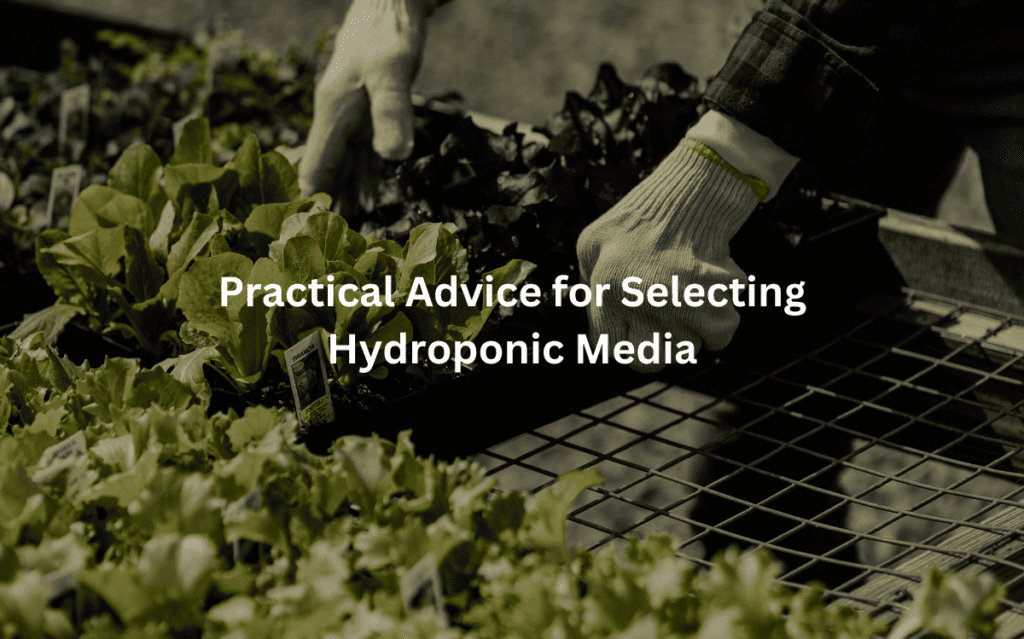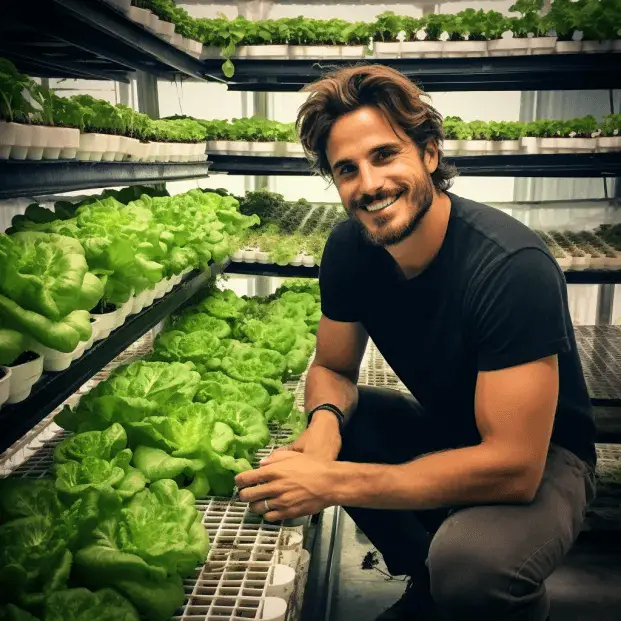Choosing the right grow media is vital for hydroponic gardening, but not all options are suitable. Avoid using soil, as it can retain too much moisture and introduce pests. Peat moss might seem appealing, but it can compact, leading to poor aeration and root rot. Coconut coir also poses risks; if untreated, it could cause nutrient imbalances that harm plant growth.
Prioritizing better alternatives like rockwool or expanded clay pellets is key for plant health. Understanding the media to steer clear of is essential for the best results in hydroponics. Keep reading to learn about optimal choices!
Key Takeaway
- Certain grow media can cause root rot and poor aeration, leading to unhealthy plants.
- Media that decompose quickly or are non-sterile can introduce pathogens and toxins.
- Being aware of unsuitable media helps ensure a more efficient and sustainable hydroponic setup.
Understanding Unsuitable Grow Media in Hydroponics
Choosing the right hydroponic growing medium to avoid problems is a lot like picking the right shoes for a long hike (1). Seems simple, but it’s not. A bad fit, and the whole trip (or crop) might suffer.
Key Issues with Problematic Hydroponic Media
1. Poor Aeration
Roots breathe. It’s easy to forget because you can’t hear them. Poor aeration media in hydroponics — like overly fine sand or sawdust — trap water and block oxygen. No air, no life.
Things to look out for:
- Overly fine media hydroponics materials (less than 1 mm particle size)
- Media that compacts easily under moisture (common in sawdust)
- Media with low porosity hydroponics systems can’t function without airflow
Poor air-to-water ratios in the root zone (should be around 25-30% air) might cause root rot hydroponics issues pretty fast. Plants look wilted even when the medium is wet. The trick is finding material that holds shape and breathes (like expanded clay, if you’re curious).
2. Inconsistent Moisture Retention
Moisture matters. Probably more than most people think. Media causing waterlogging hydroponics systems — like vermiculite — can make roots drown. Media with poor drainage hydroponics setups can also dry out overnight if it’s gravel.
Signs a medium might be trouble:
- High water retention media hydroponics (vermiculite holds 200-300% its weight in water)
- Media with poor water absorption (coarse gravel lets water rush away)
- Media that compacts under moisture (leading to “soggy roots”)
Consistent moisture is about balance. A good medium should retain 30-60% water by volume. Anything outside that swings roots into stress land, fast.
3. pH Instability
Plants don’t just “like” a pH between 5.5 and 6.5. They need it.
Media that alters nutrient solution pH? Huge headache (2). Media with high pH hydroponics examples — like untreated rockwool (pH 7-8) — throw everything off.
Common offenders:
- Media with poor chemical stability
- Media introducing unwanted nutrients (like lime-based gravel)
- Media causing nutrient lockout (plants can’t drink the minerals)
Pre-soaking rockwool in acidic water (around pH 5.5) might help, but honestly, if you’re not ready for constant testing, you probably wanna skip media causing pH imbalance hydroponics altogether.
4. Disease and Contamination Risk
Non-sterile hydroponic media? Dangerous game.
Organic materials like woodchips, rice hulls, and peat moss are media prone to pest infestation hydroponics setups. They break down. They harbor bacteria. They sometimes smell bad too (no one talks about that).
Red flags include:
- Media that decomposes quickly hydroponics (rice hulls can fully rot in under 3 months)
- Media causing bacterial growth hydroponics systems
- Media that is not sterile or clean
Using clean, inert media (coco coir that’s triple washed, for example) might keep pathogens away. Might being the keyword.
5. Environmental Impact
Plenty of popular options — looking at you, rockwool — are non-biodegradable hydroponic media. Once you’re done, you can’t compost it, you can’t burn it safely. It just sits in landfills.
Big eco problems come from:
- Media that is not recyclable hydroponics
- Media that contaminates hydroponic systems (chemical leaching)
- Media causing environmental pollution hydroponics setups
Choosing sustainable stuff (like organic coconut fiber) isn’t just a feel-good move. It’s practical. Less waste, fewer headaches.
Types of Grow Media to Avoid in Hydroponics
Rockwool Concerns
Looks like cotton candy, works like a sponge, causes more trouble than it’s worth. Even pre-soaked and buffered, rockwool’s got issues that just won’t quit.
- Holds over 80% water by volume (roots drown)
- Dangerous dust fibers need safety gear
- Starts at pH 8+ (constant adjusting needed)
- Sits in landfills forever
- Requires special disposal methods
Organic Decomposers
Natural isn’t always better. Sawdust, rice hulls, and untreated peat break down fast, taking your system with them.
- Compacts and suffocates roots
- Breeds bacteria and fungi
- Swings pH wildly
- Clogs irrigation lines
- Releases random nutrients
Problem Particles
Sand and fine gravel sound simple but create complex issues. Too heavy, too dense, or just plain wrong for hydroponics.
- Chokes out oxygen (especially sand under 2mm)
- Dries out too fast (gravel)
- Weighs down systems
- Sharp edges damage roots
- Poor nutrient retention
Moisture Extremes
Vermiculite and growstones sit on opposite ends – one drowns roots, the other dries them out.
- Vermiculite holds 400% its weight in water
- Growstones need constant watering
- Both mess with pH balance
- Neither gives roots proper air space
- Both need extensive prep work
Smart growers stick with proven media like LECA or properly prepared coco coir. Sometimes boring is better.
Reasons to Avoid These Media
Poor Structure and Aeration
It starts with a few droopy leaves, maybe some yellowing. Then the whole system crashes. Media that packs too tight (anything under 1mm) squeezes out oxygen, and roots suffocate fast. Root rot follows, every time.
- Media that compacts under water weight
- Low porosity materials like silt-heavy blends
- Dense materials prone to waterlogging
Unstable Water Retention
Some media holds too much (vermiculite at 300% water weight), while others drain too fast (pea gravel). Neither works. Plants need consistent moisture, not feast or famine.
- Materials with poor nutrient holding capacity
- Media that sticks to and suffocates roots
- Fiber mats that fall apart mid-cycle
Environmental Problems
Non-biodegradable stuff like foam blocks and some plastics just sit in landfills. Some even leach chemicals into water systems. Smart growers pick reusable or biodegradable options – expanded clay pellets, coco coir, or even rice hulls. Growing food shouldn’t mean trashing the planet.
Practical Advice for Selecting Hydroponic Media

Core Requirements
Nobody wants to wrestle with rotten roots or fight unstable pH every week. Picking the right medium means understanding what plants actually need, not what’s trendy in hydro forums (3).
- Strong aeration (25-30% air space)
- Moderate moisture holding (30-60% water by volume)
- pH neutrality (5.5-6.5 range)
- Clean and sterile starting material
- Sustainable sourcing and disposal options
Best Options
Most experienced growers stick with expanded clay pellets (LECA), perlite, and properly treated coco coir. These stay open for oxygen, hold enough water, and don’t bring unwanted problems like root rot or fungus gnats.
Take a few dead plants sometimes to figure out what works in your setup. But finding that sweet spot where roots thrive and maintenance stays minimal? Worth every failed experiment.
FAQ
What are the main types of hydroponic growing media to avoid for healthy plants?
You should stay away from hydroponic growing media to avoid that holds too much water, doesn’t let air through, or messes with your plant’s food. Unsuitable hydroponic media can cause poor plant growth. Overly fine media hydroponics can crush roots, and media causing root rot hydroponics can kill them fast. Pick media that lets water and air move easily.
Why is poor aeration media hydroponics a big problem for plant roots?
Poor aeration media hydroponics stops roots from getting air. Plants need air to stay strong. Media causing poor root aeration and media with low porosity hydroponics can trap water and choke roots. Media that compacts easily hydroponics also squeezes the air out. Plants can get sick if roots can’t breathe well.
How does media causing root rot hydroponics ruin a hydroponic system?
Media causing root rot hydroponics stays too wet and makes roots rot. Media causing water logging hydroponics holds too much water and blocks air. Media that promotes fungal growth hydroponics can bring fungus and other bad stuff. High water retention media hydroponics can drown roots and make them weak.
What risks come with overly fine media hydroponics in a setup?
Overly fine media hydroponics can block your watering system and cause big problems. It can turn into mud, making it hard for roots to grow. Media that compacts under moisture and media with poor water absorption hydroponics mess up watering and air flow. Roots need space, not mud.
Why does media with poor drainage hydroponics hurt my plants?
Media with poor drainage hydroponics makes roots sit in too much water. This media causes root damage in hydroponics. Wet roots get weak and sick. Media causing nutrient lockout can happen because plants can’t get the food they need. Wet media also lets bacteria grow fast, causing media causing bacterial growth hydroponics.
What should I know about using high water retention media hydroponics?
High water retention media hydroponics can drown your plants if you’re not careful. Media with excessive water retention holds too much water around the roots. Media that clings to roots can trap wetness and cause rot. Media with inconsistent moisture retention makes watering tricky because it doesn’t hold water the same way every time.
Conclusion
In hydroponics, it’s crucial to steer clear of grow media that compact easily, decompose, have unstable pH, or are environmentally harmful. Using such media can lead to poor plant health and growth.
Instead, options like expanded clay pellets, perlite, and properly treated coco coir strike a better balance between aeration and moisture retention. Making informed choices about grow media can significantly enhance the success of your hydroponic system. Keep reading to discover more about effective solutions!
Related Articles
- https://tophydroponicgarden.com/pros-and-cons-of-different-hydroponic-media/
- https://tophydroponicgarden.com/importance-of-ph-in-hydroponics/
- https://tophydroponicgarden.com/best-grow-media-for-beginners/
References
- https://www.homesandgardens.com/gardens/hydroponic-gardening-mistakes
- https://medium.com/@michael.toback/avoid-these-common-herb-hydroponics-mistakes-8e925568fd70
- https://www.verticalfarmdaily.com/article/9680702/tips-to-avoid-common-hydroponic-mistakes/
Was this helpful?

I’m Barrie L., a passionate hydroponic gardening enthusiast dedicated to cultivating thriving, soil-less gardens. With a focus on all things hydroponic, I share my expertise on innovative growing techniques and sustainable practices through my blog, tophydroponicgarden.com. As a seasoned hydroponics specialist, my goal is to inspire and guide fellow gardeners in harnessing the power of water-based cultivation for bountiful and eco-friendly harvests. I’m also an author of the book “Hydroponics For Absolute Beginners: Your Step By Step Guide For How To Create An Hydroponics System At Home Without Soil, For Growing Vegetable, Fruit And Herbs.” which is sold on Amazon. Join me on a journey of redefining the way we cultivate plants, one nutrient-rich solution at a time. Happy growing!


